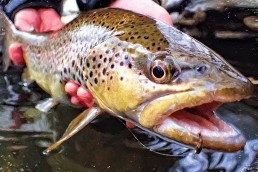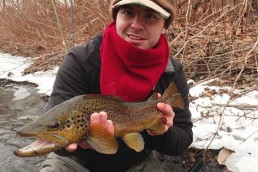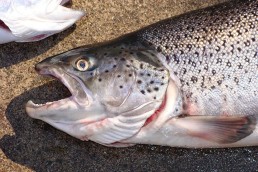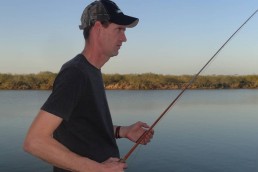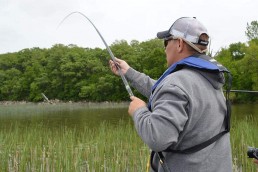Simple Trout Fishing with Essential Flies
SHARE THIS POST
Finding joy on the stream without overcomplicating things
Trout fishing with a fly rod can be as complex as an advanced degree in Entomology. But if you want to catch trout every time out without a deep dive into insects, and not spending an hour tying one fly, trout fishing with a fly rod can be as simple as fishing a few essential patterns.
When I began fly fishing at a young age, every night produced a new pattern at the tying table. I dove in to beginners’ tying books and had basic materials, but quickly began experimenting with new patterns. Looking back at some of my old boxes that I keep stowed away, it’s comical to look at my early efforts, such as nymphs 1-inch long with stripes resembling a zebra and streamers that weren’t, and still aren’t, streamers. I believe I even tried tying a few flies from household supplies I found in the kitchen.
Today, my boxes are compact, organized and most importantly, simple. What was once a collection of six boxes that went with me on the water is now two, with a tiny midge box to tag along. I don’t tie anymore to experiment, but to spend more time catching fish.
Simple patterns have always worked and will continue to do so as long as anglers bring out fly rods.
Nymphs that work
Over the years, I’ve turned into a big nymph fisherman, meaning I enjoy mimicking aquatic invertebrates beneath the surface. Trout in streams are constantly eating, even when we can’t see them, and nymphs make up the majority of that food. Without trying to mock the thousands of underwater prey species in a trout stream, there are a few must-have patterns that do a great job imitating all of them. These patterns are considered “searching patterns,” and are my favorite.
Hare’s Ears
These are without question my go-to nymphs. This fly caught my first trout on a fly rod and continues to produce for me. Not only is this fly simple, consisting of a tail, hairy body and turkey quill wing pad, but it is also a quick and easy tie.
The fly can also be tied in a multitude of colors: black, brown, tan, olive, yellow, etc. I’ve found the most effective colors are natural tans and olives. Black and brown work great for rivers with large stonefly populations. I carry this fly in a size of the tiny 18, and to 6 and the 8, mimicking larger bugs.
My boxes are full of the flies with and without bead heads. If conditions call for the angler to drag flies along the bottom of a river, such as when fishing cold conditions, a bead head works great. If trout are chasing nymphs to the surface, “nymphing” the lighter classic Hare’s Ear will produce all day. In addition, a little flash to the thorax of your Hare’s Ear can prove deadly when fish are targeting emerging nymphs.
Pheasant Tails
These nymphs are the “next best thing.” Similar to the Hare’s Ear, my nymph box wouldn’t be complete without them. Pheasant Tails are ideal copycats of most mayfly species found in the water column. They’re easy to tie with a tail, ribbed abdomen, wing-cased thorax and legs.
The most common color is a natural brown found from a pheasant’s tail—hence the name. When the tail is wrapped around to make up the body of the fly, it gives a real imitation of the microfibers on a mayfly. This is deadly to fish. Although brown is common, with today’s advancements, we can find Pheasant Tails in a wide range of colors, but I stick with brown, olives and a few blacks.
Successful fly sizes are 18 up to a larger 12, and with or without bead heads or flash. One productive hatch I utilize is a Pheasant Tail for the Blue Winged Olive mayfly hatch. BWOs are relatively tiny and smaller Tails in olive or brown are hard to beat.
Copper Johns
Copper Johns are a must in any nymph box. Unlike the hairy-bodied Pheasant Tail and Hare’s Ear nymphs, the Copper John has a body made of wire. It consists of a two-pronged tail, wired body, peacock herl thorax, flashy wing pad, legs, bead head and a dab of epoxy for the wing pad if the tier prefers. The common Copper John uses epoxy, but for time, I tie it without.
Copper Johns are flashy, heavy and in an assortment of colors, mimicking a majority of aquatic invertebrates. Unlike natural shades, I tie most of my nymphs with copper and red. However, my box is stocked with a full range of colors, including copper, red, black, brown, bright greens and blues.
A common size for this fly is 16 and 14. I don’t tie them much smaller, and I only tie larger sizes in darker shades for stonefly imitations, which have a tendency to be bigger. These flies can be greatly utilized in fast- water situations and are perfect for getting to the bottom of the water column quickly in the strike zone. The PT and Hare’s Ear nymphs work well with most water scenarios, but the Johns will outwork them in fast to deep water. And aside from its weight, is has a great shine that causes fish to react.
Are you enjoying this post?
You can be among the first to get the latest info on where to go, what to use and how to use it!
Zebra Midges
Although midges “categorize” differently from nymphs, in today’s world of fly fishing, they’re sometimes used the same way and tweaked to act as nymphs. The Zebra Midge is quite possibly the easiest fly to tie, and is effective. The only materials are a thread body with wire ribbing and a bead head.
Midges are one of a few flies that produce when nothing else does. Unlike the previous patterns, midges hatch throughout the year, including winter. Another unique factor is they can be found in almost any body of water and even old buckets filled with water you have lying around.
Like most “nymphs,” I find the common hues of black, brown and olive to work best. However, I always have the Zebra Midge stocked in red, white and cream. Midge colors vary, and it never hurts to have a wide variety. Keep in mind midge patterns such as the Zebra are very tiny, so sizes 24 to 18 are common. I know some anglers who fish it smaller than a 24, but I wouldn’t dare. At that point it’s easiest to shorten the body on the hook and take your chances. Midge patterns require long, thin tippet diameters to fool fish.
The one and only Woolly Bugger
Fly fishing has thousands of streamer patterns. To top that off, new must-have materials are being released everyday to invent newer patterns. I won’t say that you shouldn’t give these items a try, but you don’t need too for successful streamer fishing. Most trout eat smaller minnows in their watersheds than we give them credit for, such as 2- to 3-inch-long sculpin and dace. Many anglers want to throw streamers at 5 to 8 inches for large fish, but that’s far from true.
Woolly Buggers are possibly the single most effective fly for streamer fishing. With their marabou tails and hackle-covered bodies, they are deadly in the water. Trout love these, as they do a great job mimicking so many minnow-dwelling fish, as well as leeches and crayfish. My boxes have Buggers of varying size and color: olives, creams, browns, and black. I always keep a few in odd color schemes like yellow, white and even chartreuse. Sizes in 10 to 6 will cover most anything and any situation. Variety is key, and with all these colors, you can’t go wrong. Water that’s low, clear, high or muddy, you’ll now be able to find trout.
Keep in mind there are other effective streamers out there. Flies such as the Clouser Minnow, Matuka, Zonker and the Muddler Minnow have been catching trout and other species for decades. Some basic streamers catch trout daily around the globe, but the Woolly Bugger is hard to beat.
Truth about dry flies
Once aquatic invertebrates break their nymphal “shucks” and emerge through the surface (now considered a dry fly), your imitation has to be accurate. Unlike searching nymphs quickly drifting by in current, adult mayflies, caddis, stoneflies, midges or terrestrials are inspected more thoroughly by trout.
The problem with this large variety of adults is they’re so “location-specific.” What might hatch on one stream might not on a similar stream 20 miles away. The farther one gets from an area, the greater the chance of seeing totally new bugs and not being prepared. It’s hard to tell anglers what flies should always be carried.
When I lived near and fished the tailwaters of the Southeast, the only dries I truly needed were a variety of adult midge patterns. The Griffith’s Gnat was always a favorite of mine, and still is when I fish for midges. Other than the Griffith’s, one can’t go wrong with an ant or beetle pattern on a warm summer’s day.
Living out west, I learned that traditional dry flies, such as the Adams, work great for attracting trout in many rivers during different hatches. This isn’t the case on streams and rivers in the Midwest and Northeast. Also, stonefly patterns such as the Skwala and Salmonfly were common out west where I lived, but the opportunities to fish them doesn’t exist in most other places, sadly because those are such fun bugs to throw.
If I were to pick a few dries that would have a chance of working around the globe, I would say stock a few Blue Winged Olives, the Adams, different stones and caddis, an ant and a Griffith’s gnat to imitate midges. With these flies in a handful of sizes, you’re bound to hit a home run.
My point is this: There are nymphs and streamers that always get the job done when used in a variety of colors and sizes. They mimic nymphal forms and minnows around the globe well, and even when they don’t, trout can be fooled into eating them. This is not the case with dry flies. Again, they’re very site-specific, and even the same fly can look different when emerging from one stream to the next, making it nearly impossible to be prepared.
For solid proof, I’ve been fly fishing for trout for over two decades and I still get stumped when dry-fly fishing. I might think I know what’s hatching, but upon being on the banks of a river I’ve fished many times, I’m still shocked when a bug emerges that I’m not prepared for.
Keep your patterns to a minimum, gain confidence fishing them, study your local water and get out there for success on any trout stream.
MWO
SHARE THIS POST
Did you enjoy this post?
You can be among the first to get the latest info on where to go, what to use and how to use it!
Jesse Filingo
Jesse Filingo was fly-fishing at the age of 7, and fly-tying by the age of 8. His time spent with his father chasing trout in various southeastern tail waters developed his love for the art of fly fishing. He graduated from the University of Montana, earning a degree in Environmental Studies, and is an experienced fly-fishing guide and teacher, as well as being a certified fishing guide in the states of Pennsylvania and New York.

